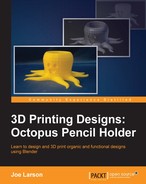Functionally, the design is complete, but as the old saying goes, it's all in the details. This little octopus would be much cuter with a face. Here's how you give it one:
- Make sure Edit mode is off (Tab) and that the 3D cursor is at the origin (Shift + C).
- Create a circle (Shift + A) by navigating to Mesh | Circle:

- Again, the newly created circle is hidden inside the octopus, so with the circle still selected, switch to Local view (Numpad /).
Since this circle will become the face, it's good to name it Face now, using the same steps for naming objects from before.
- A circle in Blender is a flat object that is just a ring of points with no face. But that's easy enough to fix:

- Switch to Edit mode (Tab).
- With all the points or edges selected (A) from the 3D View menu, navigate to Mesh | Faces | Make Edge/Face, or press F on the keyboard:

The
Make Edge/Facecommand attempts to make a connected face from the selected vertices or lines. It can be quite intelligent, but if the points are not all flat, the edges may twist unexpectedly. - While still in Edit mode, switch to top view (Numpad 7), and with all the points still selected, move (G) them to the left of the green
Y-axis line:
Duplicating in Edit mode doesn't create a new object. Whatever is selected is duplicated, but it remains a part of the object it was duplicated from. Points, lines, and faces can all be duplicated and transformed within the same object, even if it looks like they're separate parts. In this way, a face with separate eyes and mouth can be created that will still all be one face object.
- Duplicate (Shift + D) all the points and place the duplicated points on the opposite side of the green
Yaxis line:
Both eyes are still a part of the face object, even though they're separate. In the same way, objects created while in Edit mode are likewise added to the existing object.
- While still in Edit mode (making sure the 3D cursor is still at the origin), add (Shift + A) a plane to the face object by navigating to Mesh | Plane:

- Move (G) the plane down along the
Y-axis (Y) (about 3 units):
- Deselect all the points (A).
- Select the two points at the top of the plane.
- Scale (S) them up about twice to make the square a smiling mouth:

The shapes now look like a face, but only in two dimensions. If seen from a different angle, it's clear that the face is very flat. To give it the additional dimensions necessary, follow these steps:
- Select all the points (A twice) and extrude them (E) about 4 or 5 units:

- Exit Edit mode (Tab). The face template is now complete and just needs to be scaled and positioned.
- Rotate (R) the face object around the
Xaxis (X)90degrees (90):
- Exit Local view (Numpad
/). The face is hidden inside the body, so move (G) it along theZandYaxes (Shift + X) until it's outside the octopus body:
- In front Ortho view (Numpad 1), scale the face (S) and move (G) it along the
Zaxis (Z) until it's positioned properly:
- In the side Ortho view (Numpad 3), move (G) the face along the
Yaxis (Y) until it's partway inside the body:
It may help to use Wireframe view to ensure the face is deep enough but not too deep. About four or five small squares' depth (or
0.4or0.5real-world millimeters) is perfect. If it's too deep, it may cut all the way through into the cup space and create an overhang problem. The top of the mouth will rely on some bridging during prints, and that's okay. - Now, select the body and in the Modifier tab, add a Boolean modifier. Change the settings of the Boolean modifier to be a Difference operation with the face object:

- The effect of this new modifier won't be visible immediately, so select the face object and hide it (H):

Your octopus pencil holder is now complete.
Select the body, and in the Info Panel menu (at the top of the screen), go to File | Export | Stl (.stl) to export the 3D print-ready octopus holder. Be sure to choose a directory where you can find the file later in order to send it to the printer.

